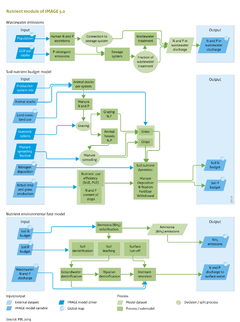Nutrients/Description: Difference between revisions
Jump to navigation
Jump to search
No edit summary |
No edit summary |
||
| Line 56: | Line 56: | ||
====Other sources==== | ====Other sources==== | ||
Other sources include aquaculture, weathering and atmospheric deposition. Deposition is from the same data as used for the land nutriënt budgets. Aquaculture is taken from data from two recent studies, and weathering. The calculation of P release from weathering is based on a recent study ([[Hartmann et al., 2014]]) which uses the lithological classes distinguished by ([[Dürr et al., 2005]]). The lithological classes are available on a 5 by 5 minute resolution, hence the weighted average P concentration within each 0.5 by 0.5 degree grid cell is calculated. | Other sources include aquaculture, weathering and atmospheric deposition. Deposition is from the same data as used for the land nutriënt budgets. Aquaculture is taken from data from two recent studies ([[Bouwman et al., 2011]]; [[Bouwman et al., 2013c]]), and weathering. The calculation of P release from weathering is based on a recent study ([[Hartmann et al., 2014]]) which uses the lithological classes distinguished by ([[Dürr et al., 2005]]). The lithological classes are available on a 5 by 5 minute resolution, hence the weighted average P concentration within each 0.5 by 0.5 degree grid cell is calculated. | ||
====In-stream nutrient retention==== | ====In-stream nutrient retention==== | ||
The water that enters streams and rivers through surface runoff and discharges from groundwater and riparian zones is routed through stream and river channels, and passes through lakes, wetlands and reservoirs. The nutrient retention in each of these systems is calculated on the basis of the nutrient spiralling ecological concept, which is based on residence time and temperature as described in ([[Beusen et al., 2014]]; [[Beusen et al., 2015]]). | The water that enters streams and rivers through surface runoff and discharges from groundwater and riparian zones is routed through stream and river channels, and passes through lakes, wetlands and reservoirs. The nutrient retention in each of these systems is calculated on the basis of the nutrient spiralling ecological concept, which is based on residence time and temperature as described in ([[Beusen et al., 2014]]; [[Beusen et al., 2015]]). | ||
}} | }} | ||
Revision as of 15:12, 2 November 2016
Parts of Nutrients/Description
| Component is implemented in: |
| Components: |
| Related IMAGE components |
| Projects/Applications |
| Key publications |
| References |
